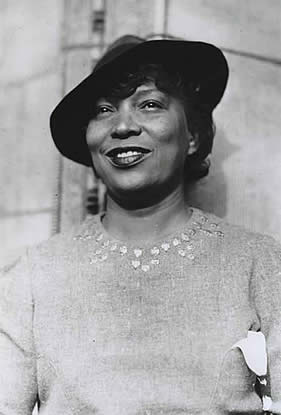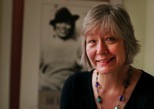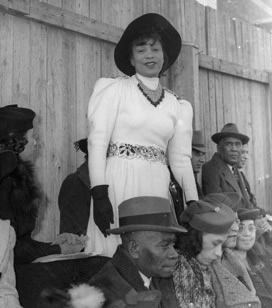Jump at the Sun: A Biography of Zora Neale Hurston
Film Screening and Discussion
The Studio@620 welcomes filmmaker Kristy Andersen on Saturday March 6 for a screening of her documentary film  "ZORA NEALE HURSTON: JUMP AT THE SUN". After the film there will be a short discussion featuring Andersen and Dr. Lois Gaston. Dr. Gaston is the great-niece of Zora Neale Hurston. Andersen will sell dvds, with a portion of sales going to Community Tampa Bay, a nonprofit organization that promotes dialogue and respect among cultures, religions and races in the bay area.
Film runs 84 minutes, discussion will last approximately 30 minutes. Pay what you will at the door.
"ZORA NEALE HURSTON: JUMP AT THE SUN". After the film there will be a short discussion featuring Andersen and Dr. Lois Gaston. Dr. Gaston is the great-niece of Zora Neale Hurston. Andersen will sell dvds, with a portion of sales going to Community Tampa Bay, a nonprofit organization that promotes dialogue and respect among cultures, religions and races in the bay area.
Film runs 84 minutes, discussion will last approximately 30 minutes. Pay what you will at the door.
Flamboyant, scandalous, and unpredictable: writer Zora Neale Hurston (1891-1960) was one of the first black anthropologists in the United States, tracing the history of African American folklore and ethnic traditions. Born to a former slave, she grew up in the all-black town of Eatonville, Florida, and became one of the most illustrious and controversial figures of the 1920s Harlem Renaissance. She collaborated with poet and playwright Langston Hughes, with whom she co-founded the
 publication Fire!!, was strongly criticized by writer Richard Wright and the black male intelligentsia for her failure to take a political stance, and died in poverty and obscurity in Ft. Pierce, Florida. Resurrected by novelist Alice Walker, Hurston is now seen as a pioneer of African American literature. Her books, including the classic Their Eyes Were Watching God -the first explicitly feminist novel in black literature- and Dust Tracks on a Road, are essential reading in American classrooms today. The film uses previously unseen archival footage from the rural South and conversations with Alice Walker, Dorothy West, Henry Louis Gates Jr., Maya Angelou and Hurston's friends and family as well as a 1943 radio interview with the author, re-enacted by actress Kim Brocklington.
publication Fire!!, was strongly criticized by writer Richard Wright and the black male intelligentsia for her failure to take a political stance, and died in poverty and obscurity in Ft. Pierce, Florida. Resurrected by novelist Alice Walker, Hurston is now seen as a pioneer of African American literature. Her books, including the classic Their Eyes Were Watching God -the first explicitly feminist novel in black literature- and Dust Tracks on a Road, are essential reading in American classrooms today. The film uses previously unseen archival footage from the rural South and conversations with Alice Walker, Dorothy West, Henry Louis Gates Jr., Maya Angelou and Hurston's friends and family as well as a 1943 radio interview with the author, re-enacted by actress Kim Brocklington.
About the Film
Jump at the Sun is the first feature length documentary on Zora Neale Hurston.
With footage of Zora, and her actual voice singing and talking, it's a tour de force.
Chock full of her anthropological footage shot or produced in 1927 and 1943, it
swells with an honest verve, never losing its melodic pace. Today
there's no question that Zora is a major force, a race champion, one of the
greatest writers of her time, and a pioneer in feminist perspective and philosophy.
The film puts to ample use the blues and folk music that Zora gleaned with
musicologist Alan Lomax, and includes Zora's explanations of African-American
tradition and verse. The film is narrated by
S. EPATHA MERKERSON and stars
ZORA NEALE HURSTON
as herself as well as
KIM BROCKINGTON
as Zora Neale Hurston. Also featuring
MARCELINE HUGOT
as Mary Margaret McBride.
Featured Interviews include conversations wtih
ALICE WALKER,
MAYA ANGELOU,
DOROTHY WEST, and
HENRY LOUIS GATES.
Produced and Written by KRISTY ANDERSEN
Directed by SAM POLLARD
About the Filmmaker
Bay Bottom News, a production company founded two decades ago by filmmaker Kristy Andersen,  produced ZORA NEALE HURSTON: JUMP AT THE SUN in conjunction with PBS’ American Masters series. Kristy Andersen also wrote the script for the film, and conducted most of the films’ interviews. The company has created many highly-acclaimed films about Florida’s environment, and the state’s history and culture, for local, state, and national distribution.
produced ZORA NEALE HURSTON: JUMP AT THE SUN in conjunction with PBS’ American Masters series. Kristy Andersen also wrote the script for the film, and conducted most of the films’ interviews. The company has created many highly-acclaimed films about Florida’s environment, and the state’s history and culture, for local, state, and national distribution.
Kristy Andersen has worked in film and broadcast production since 1974 at television stations in the Tampa Bay area, C-SPAN and the House of Representatives Recording Studio in Washington, D.C. She began producing environmental programs independently in 1985 after producing Bay Bottom Blues, a documentary about the demise of sea grass in Tampa Bay. She received an Emmy Award for her 1989 documentary film, Sea Turtles Last Dance, about endangered Kemps Ridley turtles broadcast nationwide on PBS. Andersen's short films can be seen in museums and tourism venues in the Tampa Bay area. She began researching Zora Neale Hurston's life in 1991 with a grant from the Florida Division of Cultural Affairs. She broadened her research to eight states through Humanities Council's grants and unveiled many details of Hurston's life that had been obscured, including Hurston's birthplace in Notasulga, Alabama, not Florida. Andersen worked helped the Library of Congress locate and identify film footage Hurston shot in South Carolina, hidden away in boxes since 1940. In 1999 Andersen's discovery of Zora's manuscript Folk Tales from the Gulf States in the Smithsonian's computer files lead to Every Tongue Got to Confess, the first new book by Zora Neale Hurston since 1948. Andersen interviewed countless people over the years who knew Zora Neale Hurston, helping to bring to the film a true picture of one of America's great talents.
About Guest Panelist Lois Gaston
Lois Gaston is Zora Neale Hurston's great-niece. Her grandfather, Dr. Hezekiah Robert Hurston, was Zora's brother, a surgeon, and the eldest of nine children born to Reverend John Hurston and Lucy Potts Hurston. Dr. Gaston first heard of her famous great-aunt when she was in high school but her knowledge of Zora Neale Hurston began to blossom in 1993 when she became co-trustee of the Hurston Trust. In 1984, Dr. Gaston received her doctorate from Illinois State University, and after more than 20 years living in Peoria and working in higher education, Dr. Gaston moved to Tampa to become President of the Ybor City campus of Hillsborough Community College. In 2006 , Dr. Gaston retired and is currently living in Valrico with her husband, Eric Gaston.
About Zora Neale Hurston
Zora Neale Hurston (January 7, 1891 – January 28, 1960) was an American folklorist and author during the time of the Harlem Renaissance. Of Hurston's four novels and more than 50 published short stories, plays, and essays, she is best known for her 1937 novel Their Eyes Were Watching God.
Hurston was the fifth of nine children. Her father was a Baptist preacher, tenant farmer, and carpenter, and her mother was a school teacher. Her family moved to Eatonville, FL, the first all-Black town to be incorporated in the United States, when she was three. Her father later became mayor of the town, which Hurston would glorify in her stories as a place black Americans could live as they desired, independent of white society. Hurston spent the remainder of her childhood in Eatonville, and describes the experience of growing up in Eatonville in her 1928 essay "How It Feels to Be Colored Me".
Hurston was sent away to boarding school in Jacksonville, Florida, but was eventually expelled for failure to pay tuition. She later worked as a maid to the lead singer in a traveling Gilbert & Sullivan theatrical company. In 1917, Hurston began attending Morgan Academy, the high school division of Morgan College in Baltimore, Maryland. It was at this time, and apparently to qualify for a free high-school education, that the 26-year-old Hurston began claiming 1901 as her date of birth. She graduated from Morgan Academy in 1918.
When Hurston arrived in New York City in 1925, the Harlem Renaissance was at its peak, and she soon became one of the writers at its center. By the mid-1930s, Hurston had published several short stories and the critically acclaimed Mules and Men (1935), a groundbreaking work of "literary anthropology" documenting African American folklore. In 1930, she also collaborated with Langston Hughes. Her last published novel, Seraph on the Suwanee, notable principally for its focus on white characters, was published in 1948. --Courtesy of Wikipedia
